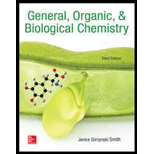
(a)
Interpretation:
The product formed when p-dichlorobenzene is treated with
Concept Introduction:
The electrophilic substitution reactions are the most common reactions of
These reactions occur in the presence of certain catalyst like
(b)
Interpretation:
The product formed when p-dichlorobenzene is treated with
Concept Introduction:
The electrophilic substitution reactions are the most common reactions of aromatic compounds. It involves the substitution of one of the H atom of aromatic ring with electrophile. It leads to the formation of arenium ion as an intermediate which immediately loses hydrogen ion to form the substituted product.
These reactions occur in the presence of certain catalyst like
(c)
Interpretation:
The product formed when p-dichlorobenzene is treated with
Concept Introduction:
The electrophilic substitution reactions are the most common reactions of aromatic compounds. It involves the substitution of one of the H atom of aromatic ring with electrophile. It leads to the formation of arenium ion as an intermediate which immediately loses hydrogen ion to form the substituted product.
These reactions occur in the presence of certain catalyst like
Want to see the full answer?
Check out a sample textbook solution
Chapter 13 Solutions
General, Organic, & Biological Chemistry
- The foul odor of rancid butter is caused by butyric acid, CH3CH2CH2CO2H. (a) Draw the Lewis structure and determine the oxidation number and hybridization for each carbon atom in the molecule. (b) The esters formed from butyric acid are pleasant-smelling compounds found in fruits and used in perfumes. Draw the Lewis structure for the ester formed from the reaction of butyric acid with 2-propanol.arrow_forwardWhen the conjugate acid of aniline, C6H5NH3+, reacts with the acetate ion, the following reaction takes place: C6H5NH3+(aq)+CH3COO(aq)C6H5NH2(aq)+CH3COOH(aq) If Kafor C6H5NH3+ is 1.35105 and Kafor CH3COOH is 1.86105 , what is K for the reaction?arrow_forwardIsooctane is the common name of the isomer of C8H18 used as the standard of 100 for the gasoline octane rating: (a) What is the IUPAC name for the compound? (b) Name the other isomers that contain a five-carbon chain with three methyl substituents.arrow_forward
- The monomers H H -H and H- но- (CH2)4-C-OH OH он would react with each other to form a polycarbonate a polyamide a polyesterarrow_forwardWrite the equations for the preparation of alcohols by reacting a) propene with sulfuric acid and water b) chlorocyclohexane and sodium hydroxide Write the equations for the reaction of phenoxybenzene with hot concentrated HCIarrow_forwardWhat is the chemical equation involved with the reaction of cyclohexene with Br2?arrow_forward
- draw and write the chemical equation of the following situations: Reaction of acetylene with LIME WATERarrow_forwardWhat happens when (i) chlorobenzene is treated with Cl2/FeCl3,(ii) ethyl chloride is treated with AgNO2, and(iii) 2-bromopentane is treated with alcoholic KOH?arrow_forwardWhat is the chemical equation when nitrating mixture is added to the following:(a) Cyclohexane (b) Cyclohexene(c) Toluenearrow_forward
- What hydrocarbon with the molecular formula C4H10 forms three monochlorinated products? One is achiral and two are chiral.arrow_forwardVanillin, C8H8O3, is the active ingredient in vanilla flavoring. It contains a six-membered aromatic ring with an aldehyde group on carbon 1, an alkoxy group (ether) on carbon 3, and a hydroxyl group (alcohol) on carbon 4. Draw the structure of vanillin.arrow_forwardPredict the reactants for the products: 1) methoxypropane 2) Methoxybenzene 3) Cyclohexanethiol 4) 2-ethylthiopropanearrow_forward
 Chemistry: Principles and PracticeChemistryISBN:9780534420123Author:Daniel L. Reger, Scott R. Goode, David W. Ball, Edward MercerPublisher:Cengage Learning
Chemistry: Principles and PracticeChemistryISBN:9780534420123Author:Daniel L. Reger, Scott R. Goode, David W. Ball, Edward MercerPublisher:Cengage Learning Chemistry: Principles and ReactionsChemistryISBN:9781305079373Author:William L. Masterton, Cecile N. HurleyPublisher:Cengage Learning
Chemistry: Principles and ReactionsChemistryISBN:9781305079373Author:William L. Masterton, Cecile N. HurleyPublisher:Cengage Learning Chemistry: The Molecular ScienceChemistryISBN:9781285199047Author:John W. Moore, Conrad L. StanitskiPublisher:Cengage Learning
Chemistry: The Molecular ScienceChemistryISBN:9781285199047Author:John W. Moore, Conrad L. StanitskiPublisher:Cengage Learning General Chemistry - Standalone book (MindTap Cour...ChemistryISBN:9781305580343Author:Steven D. Gammon, Ebbing, Darrell Ebbing, Steven D., Darrell; Gammon, Darrell Ebbing; Steven D. Gammon, Darrell D.; Gammon, Ebbing; Steven D. Gammon; DarrellPublisher:Cengage Learning
General Chemistry - Standalone book (MindTap Cour...ChemistryISBN:9781305580343Author:Steven D. Gammon, Ebbing, Darrell Ebbing, Steven D., Darrell; Gammon, Darrell Ebbing; Steven D. Gammon, Darrell D.; Gammon, Ebbing; Steven D. Gammon; DarrellPublisher:Cengage Learning Chemistry & Chemical ReactivityChemistryISBN:9781133949640Author:John C. Kotz, Paul M. Treichel, John Townsend, David TreichelPublisher:Cengage Learning
Chemistry & Chemical ReactivityChemistryISBN:9781133949640Author:John C. Kotz, Paul M. Treichel, John Townsend, David TreichelPublisher:Cengage Learning Chemistry & Chemical ReactivityChemistryISBN:9781337399074Author:John C. Kotz, Paul M. Treichel, John Townsend, David TreichelPublisher:Cengage Learning
Chemistry & Chemical ReactivityChemistryISBN:9781337399074Author:John C. Kotz, Paul M. Treichel, John Townsend, David TreichelPublisher:Cengage Learning





